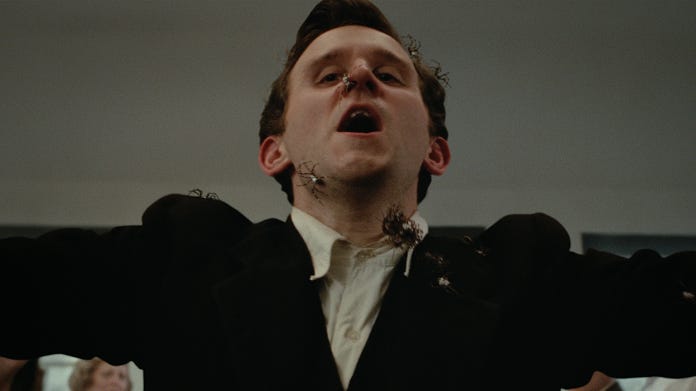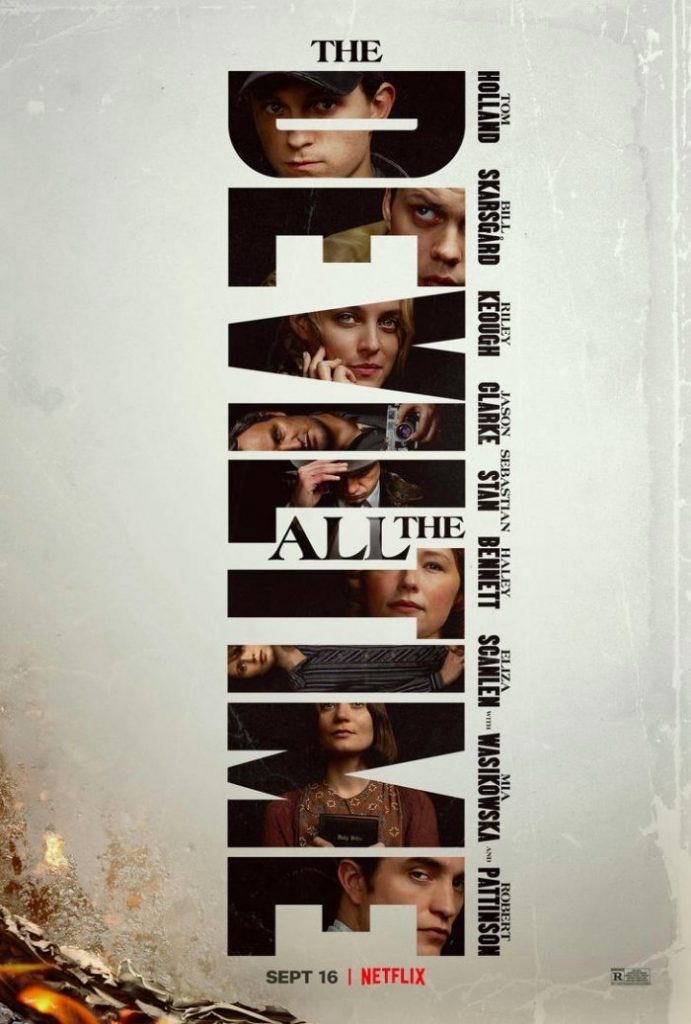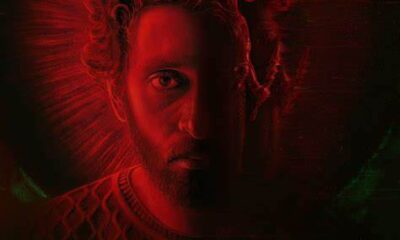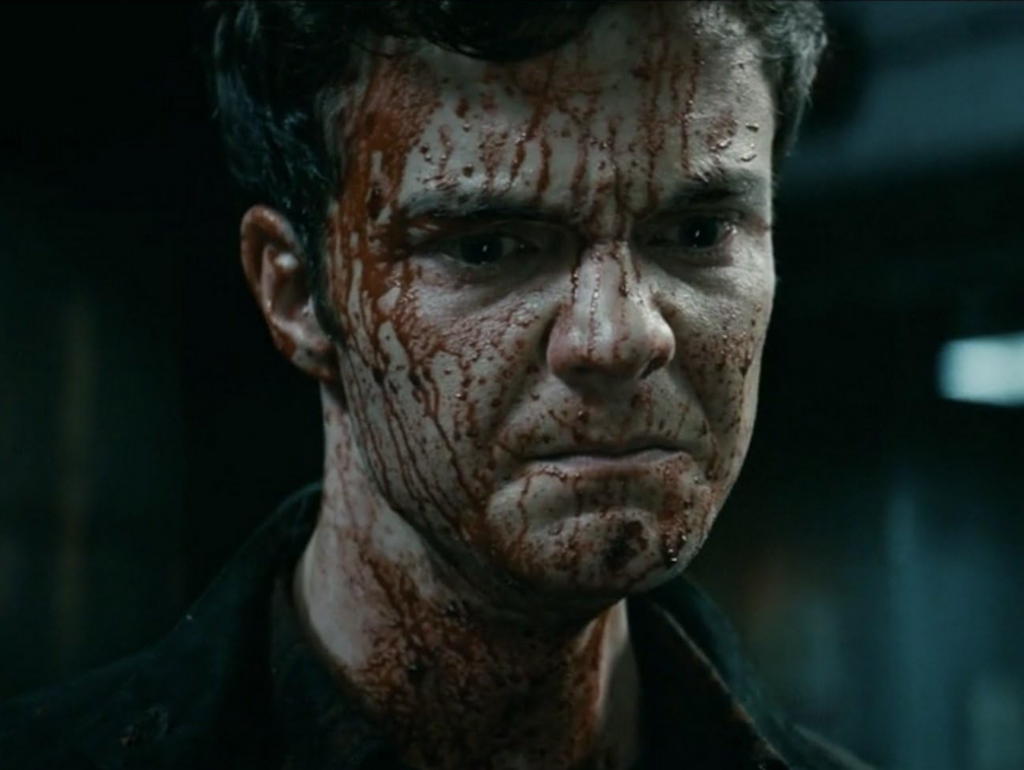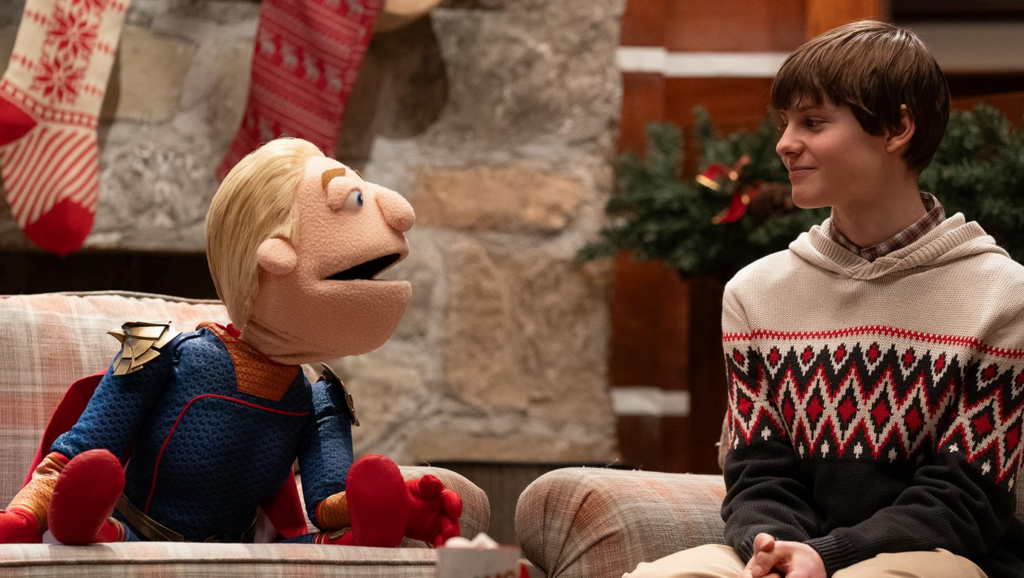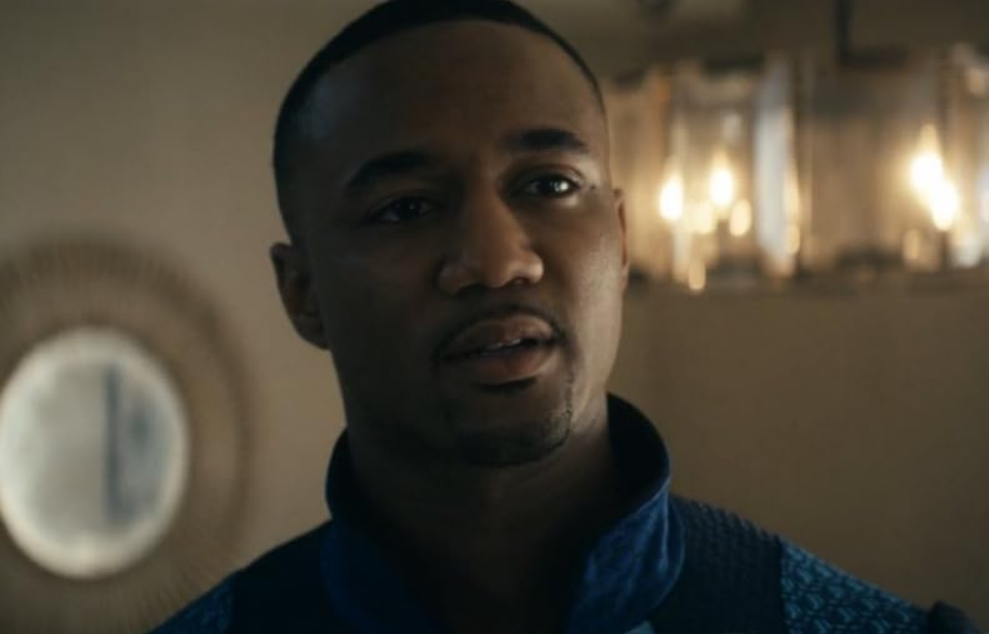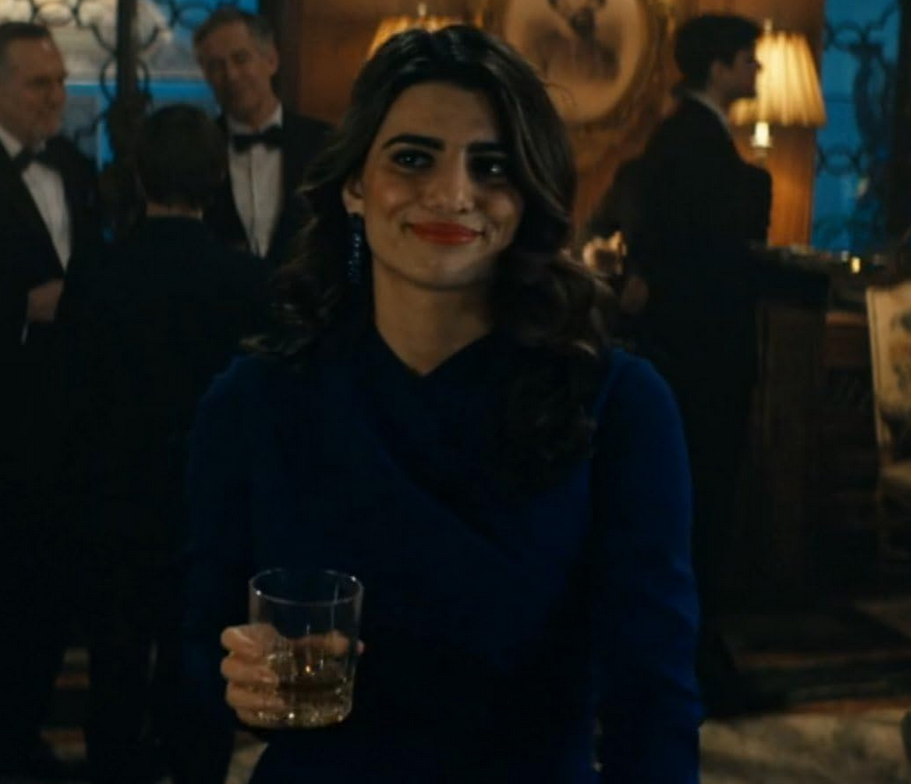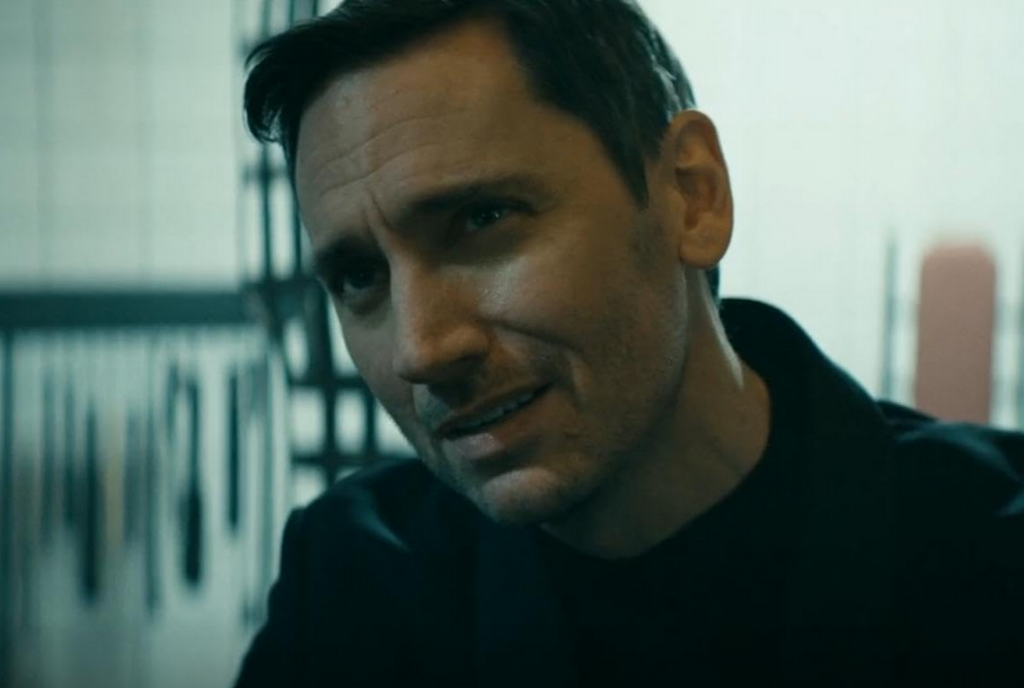
God has no time for sinners in the southern gothic thriller The Devil All The Time
More Videos
Published
4 years agoon
By
Rachel Roth
Based on the novel by Donald Ray Pollock, The Devil All The Time is an ambitious, 138-minute feature that follows three different storylines all packed tight with religious fright. If you’re against organized religion, this film will probably reaffirm your disdain. It features an all-star cast that are all thieves of the spotlight. Each and every one shines bright when on screen. No one falls flat. The performances are incredible and without them, this film would be nothing but a beautifully painted empty cardboard box. Most impressive are Tom Holland, Bill Skarsgard, Robert Pattinson, and Harry Melling.
Spider-Man, Pennywise, Edward Cullen, and Dudley Dursley have all left the building.
Although not a bad film by any means, The Devil All The Time never gets the chance to properly take off. The biggest issue is that it’s actually too short. Two hours and eighteen minutes is a long runtime but for the story that it’s telling, it’s not long enough. It either needs to be longer or turned into a miniseries. If it had perhaps been spread out into four hour-long episodes, The Devil All The Time could’ve been something magnificent. There are too many characters and too many subplots. Its a bit too much crammed into a small space. Don’t let the length fool you, it is a very small space.
Also, there’s a narrator which I absolutely HATE! The narrator is the author himself, literally, who is only there to simplify the plot in an audiobook-like fashion. I really hate it.

The past
The whole first act is essentially just a prologue. This part of the book is titled, “Sacrifice.” Take that as you will. It runs for a whole 41 minutes before the main character, Arvin Russell (Tom Holland) is finally put in the driver’s seat. Everything up to that point is backstory. The film starts in 1945, with WWII veteran Willard Russell (Bill Skarsgard) home from the war but haunted by the horrors he witnessed. He lives tormented by his own struggling faith until he falls in love with a good-natured waitress named Charlotte (Hayley Bennett) and has a son, Arvin.
Meanwhile, we’re also introduced to Helen (Mia Wasikowska), a woman whom Willard’s mother had hoped he would marry before he met Charlotte. Instead, she marries the terrifying, deranged, and overtly righteous preacher Roy Laferty (Harry Melling). They have a daughter named Lenora, whose fate becomes intertwined with Arvin’s when both their parents suffer tragic ends. They are left as orphans and together go to live with Arvin’s grandmother, where they grow up as siblings.
The past comes back to haunt
Just the way the first half feels like a prologue, a lot of the second half feels like an epilogue. There is a brief section in the middle that feels like it might be the centerpiece but it’s fleeting and comes off as nothing but a dolly used to carry the film’s baggage over into the next scene.
Jumping ahead to 1965, Arvin and Lenora (Eliza Scanlen), now about 15, are still coping with the loss of their parents. After seeing his father’s mental deterioration in front of a cross, Arvin has lost faith in any sort of higher power. While Lenora puts her loss into her faith. I won’t say what happens after that but just know that it’s a slow burn of events that ends with Arvin going on an unintentional murder spree.
Everything about the film is part of a plot. Nothing is filler, which sometimes a movie needs to give it life. The Devil All The Time seems reluctant to admit that the past and present should be their own separate stories. It attempts to weave them together as if they’re one and the same, giving no room for breathing. Which is ironic because it’s also incredibly slow. One major flaw is the subplot involving a sheriff played by Sebastian Stan and a serial killer couple played by Jason Clarke and Riley Keonugh. They feel completely out of place and are really only there to enforce the third act, and it’s clear that this is because the film just couldn’t fit them in. It’s a shame too. If given more focus, this would have been a much more disturbing film. However, Stan does have the best line: “Some people were born just so they could be buried.” Make that the tagline.
Verdict
The Devil All The Time is too slow to be exciting and too brutal to be relaxing but it has its moments. There’s a large overreaching theme about testing your faith. Not necessarily religious, but faith in anything; in one’s self, in others, in family members. Everyone in the film is looking for a way to see God and some are so desperate for it, that they invertedly turn into sinners. Everyone descends into darkness and everyone is connected.
Despite my complaints, I honestly did enjoy this film. There are some blood splatters here and there and one momentarily disturbing image of a crucified dog, but other than that. this is not a typical horror film. Any horror that takes place is all internal. The setting is quaint, beautiful, but it’s the human characters that strike fear in the heart.

All photos owned by Netflix, Nine Moving Productions and Bronx Moving Company.
Rachel Roth is a writer who lives in South Florida. She has a degree in Writing Studies and a Certificate in Creative Writing, her work has appeared in several literary journals and anthologies. @WinterGreenRoth

You may like
We have come now to the finale of season four of The Boys. And while it didn’t have the literal blood fireworks I wanted, someone did get ripped in half in the air. So, that’s pretty close.
As a note, I will try to avoid spoilers as much as possible. This ending was a hell of a gut punch that should be experienced as blindly as possible. That being said, I will not be able to avoid spoilers and still give a full legitimate review. Proceed at your own risk.
The story
The main storyline for this episode is the attempted assassination of President-Elect Robert Singer. The Boys join forces with the Secret Service to protect him. But, as we learned last episode, Annie has been replaced with a shapeshifter. A shapeshifter that was welcome not just into Hughie’s anus, but into the protective bunker in which the President-Elect is hiding.
What worked
The first thing I want to discuss about this episode is the ending. But we need to do this carefully.
The important thing here is that the ending breaks your heart on so many levels. So many terrible things are happening to characters that it’s almost hard to keep track. And each moment is significant to each character.
I cannot give a specific example. But no matter who your favorite character is, you’re going to weep for them.
Unless your favorite character is Sage. And this is the next thing that made this episode so fantastic.
I don’t think I’m spoiling anything to say that Sage’s plans worked out exactly as she wanted them to. And she got exactly what she wanted.
What she wanted wasn’t power. It wasn’t money or fame or vengeance. It wasn’t to win the love of anyone. She just wanted to see if she could do it.
That is a terrific, terrifying motivation! Because all she wants is to play a massive game of chess with people as pieces. She doesn’t care about anyone. She just wants to see how many people she can manipulate. She just wants to set things on fire to see if she can.
Fantastic. A plus villain work.
The next thing I want to discuss is a cornerstone of the whole series.
The morality of The Boys shifts through the series. While it’s very much a battle to save the world from overpowered super monsters, it’s also a battle for the souls of our real heroes. And in that battle, there are two warring factors. We have Hughie, always trying to bring everyone up to a better level. And we have Butcher, who has no problem at all hitting rock bottom with a shovel in hand to do some more digging.
In this episode, we saw almost every member of The Boys challenged. Will they rise to their higher angels, or sink with their demons?
On a similar note, I am so glad that the writers kind of addressed my issues with Annie. They did this by having the shapeshifter get right into her face and accuse her of thinking that she’s better than everyone.

While that was devastating for the character, it was a little cathartic for those of us who felt like Annie was a little too good of a good guy.
What didn’t work
This is a small matter, but it is an issue that I want to address. After Annie finds out that Hughie slept with her doppelganger, she is furious at him.
In addition to this being unfair, it’s also a very cliche element to add. In almost every instance of a lookalike in fiction, there’s a moment where the love interest of the victim is fooled. Or almost fooled. And it’s always the same fight. It’s just played out and predictable. I’m just glad that it didn’t last very long.
Now that we’ve come to the end of the season, I can officially say that it was amazing. The story was deep and rich. The special effects were a stomach-turning good time. The character development was spot-on and satisfying. And, of course, it left me just about gagging to see what happens next. Unfortunately, it looks like we’ll have a bit of a wait. Because as of right now, the fifth season isn’t expected until 2026.

We’ve reached the second to last episode of The Boys, season four. And, as is appropriate for the penultimate episode of any show, things have to get a lot worse before they can get better.
Let’s discuss.
The story
Christmas is coming, and the whole world is getting ready. Ryan, despite being very clear that he didn’t want to appear on any TV shows or movies, has been strong-armed into participating in a Vought puppet Christmas special. He draws the line, though, when asked to sing about turning one’s parents in if they start talking about woke things.
Meanwhile, The Boys are trying to keep each other together. Butcher decides to take Sameer to the rest of the team. He also gets Frenchie out of prison, hoping they can make the Sup virus necessary to finally take down Homelander. Instead, this decision means disaster for one member of the team.
What worked
I first want to talk about Ryan’s speech near the end of the episode. Because it was exactly the moral of this whole story.
Ryan’s dad is a monster. His stepdad is also kind of a monster. But Ryan is a good kid. He cares about people, about family. And while he loves Homelander and Butcher, he doesn’t want to be like them.
Even better, this speech sounded like something a kid would say. Ryan didn’t open his mouth and start sounding like a college student all of a sudden. He sounds like a kid who misses his mom and wants to live up to the good standards she set for him. And I think that’s terrific.
Speaking of Homelander, he shot himself in the foot in this episode. I said earlier in the season that his hubris was going to be his downfall, and I was right. Without Sage, he just has the same weaknesses he’s always had. He’s going to fail because he just isn’t clever enough or patient enough to succeed.
Without Sage, I think a win is in the bag for The Boys. This isn’t to say that Homelander by himself isn’t dangerous. It’s just that he’s more like a wildfire than a controlled burn. He’s going to cause a lot of damage, but not get anything he wants out of it.
More’s the pity for him and everyone else who has to share his world.
Finally, I am thrilled with A-Train’s redemption story. I love that he wants to be a good person not to save himself, but to be a good person. His honest, pure and warm reaction to that little kid smiling at him in the last episode was heartwarming. It changed him in a moment, bringing to light a goodness that he’s been keeping under wraps for a long time.
This, along with Ryan’s courageous speech, proves once again what The Boys does so well. Yes, it’s gruesome. Yes, there’s blood and balls and batshit events. Yes, someone occasionally gets ripped in half. But there is a true human goodness in the story. One that we catch glimpses of. There are good people among the monsters. There is hope for redemption.
What didn’t work
Of course, so few things in this life are perfect, and this episode was no exception. For instance, I was irritated by the insinuation that Butcher cheated on his wife.
That just doesn’t make any sense. We’ve seen flashbacks of Billy and Becca. They were happy. He was happy. He was head over heels for her. And I don’t think it’s realistic or necessary for the character to throw in that he cheated. It does nothing to add to the story, it’s just a weird and offputting moment.
Doesn’t Butcher have enough to hate about himself? Can’t we just give him that at least he was a good husband?
Finally, I kind of hate that we ended up with Annie being caught. It’s just cliche, which is something I don’t normally say about this show. It feels lazy unless they do something very clever with it in the last episode. Which, I suppose, they might.
Next up is the season finale. And with this season being as insane as it has been, I’m expecting nothing short of bloody fireworks. And I mean literal fireworks of blood. At this point, would it surprise anyone?
 (4 / 5)
(4 / 5)
Episode six of The Boys was one of the most surprising episodes of the series so far. And that is certainly saying something. Because this season has so far been bonkers.
The story
Our episode today revolves around a party at Tek Knight’s lovely mansion. Yes, it does look just like Wayne Manor.
The Boys know that Tek Knight is working with Homelander on something, but they don’t know the details. So they decide to send Hughie in to bug the mansion.
Because that’s worked so well the other two times he’s tried to hide a bug!
It should surprise no one that this time goes no better. Hughie finds himself in Tek Knight’s basement. And by that I mean his BDSM dungeon.
Meanwhile, the party upstairs is no less disturbing. Homelander and Sage are trying to convince some well-off political donors to support a cue after the election. When pressed for details on his plan, Homelander freezes. He looks to Sage for help, but she wasn’t recently shot in the head and still in the junk food stage of her healing.
Fortunately, or unfortunately depending on your point of view, Neuman jumps in and saves the day.
What works
If I’m going to say one thing about this episode, it didn’t hold back at all. I didn’t expect them to show a character masturbating, sitting their bare behind on a cake, or spraying breastmilk into someone’s face. But every time I thought they’d cut the scene and let something be left to our imagination, they did not do that.
This is a dangerous move. Whenever you show the monster, you run the risk of them not being scary enough, or gross enough. As Stephen King says in Danse Macabre, to leave this sort of thing to the imagination if the reader makes things so much worse. So when they finally experience the monster, they might say that this isn’t so bad. It could have been so much worse.
But in this case, they managed to avoid that by making the scenes, especially the ones in Tek Knight’s dungeon, so much worse than I imagined it would be.
What doesn’t work
While this was a deeply disturbing episode in many ways, there was one really innocent and sweet moment.
And yes, I did have a problem with it.
Confronted by Firecracker, Annie decides to apologize for spreading rumors about her when they were kids. She tells her that she is genuinely sorry.
And I believe her. I don’t think Firecracker did, but I did.
So why is this an issue? Because I’m starting to think that Annie is maybe too nice. She is too good.
I know that Annie is our good guy. But every one of the other good guys has flaws. Hughie let his pride get in the way and took Temp V. MM hid himself from his daughter instead of teaching her to work through her emotions. Kimiko is far too closed off and has a hard time trusting others. Frenchie numbs himself with drugs. And well, what hasn’t Butcher done?
It is unrealistic that Annie is just so kind and so flawless. We all have shadows in our personalities. We all have weaknesses, we all mess up. We all do things we wish we could take back. The fact that Annie doesn’t seem to have anything like that is not just unrealistic. It’s infantilizing.
Give her some deep dark secrets. Give her something real to regret.
This was a shocking episode, even for someone fairly jaded like me. I wasn’t expecting the sort of weird sexual depravity, though I guess maybe I should have seen it coming. It was dark, upsetting, tense, and funny as hell. And with just two episodes left in the season, I can imagine the stakes are only going to get higher.
 (4 / 5)
(4 / 5)
By the way, if you like my writing you can get my short story, Man In The Woods, on Smashwords and Amazon.

